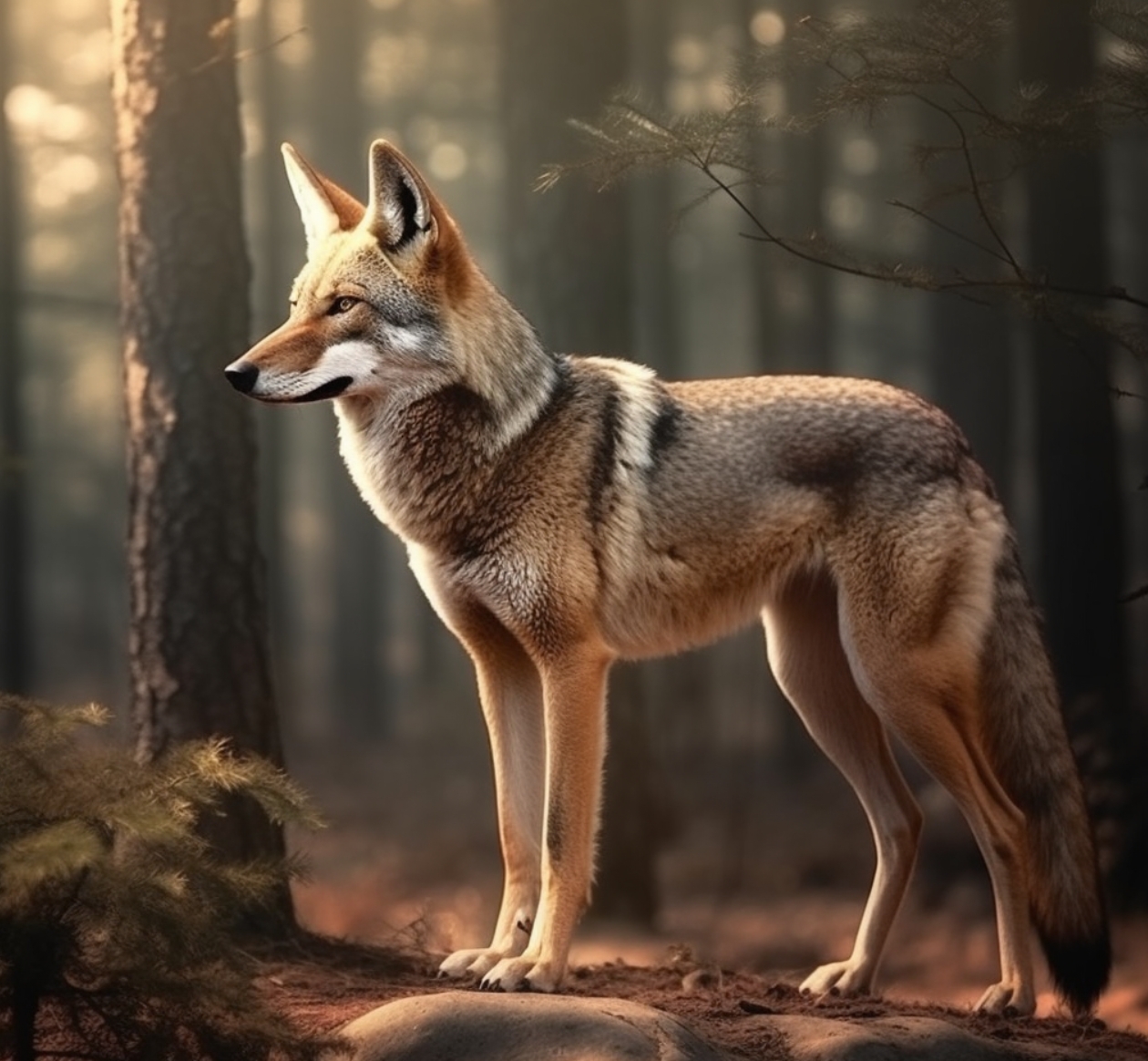Coyotes are fascinating animals that have captured the imagination of many with their wily ways, cunning nature, and impressive speed. But just how fast can coyotes run? In this article, we’ll explore the incredible capabilities of these nimble creatures, diving deep into their speed and agility. We’ll also touch on topics such as how to build a coyote fence and how high a coyote can jump, so you can better understand and appreciate these fascinating animals.
The Need for Speed: Coyote Sprinting Capabilities
Contents
When it comes to sheer speed, coyotes are no slouches. These speedy critters can reach top speeds of up to 43 miles per hour (mph), or approximately 69 kilometers per hour (km/h). This incredible velocity puts them among the fastest animals in North America and allows them to effectively hunt their prey, evade predators, and traverse large distances in search of food and mates.
Factors Influencing Coyote Speed
While 43 mph is an impressive figure, it’s important to note that not all coyotes are created equal. A coyote’s speed can be influenced by a variety of factors, including:
- Age: Younger coyotes tend to be faster than older ones, as they have more energy and less wear and tear on their bodies.
- Size: Larger coyotes are generally faster than smaller ones, as they have longer legs and a more powerful stride.
- Health: A healthy coyote with a strong, well-maintained body will be able to run faster than one that is injured or malnourished.
- Terrain: Coyotes can reach higher speeds on flat, open ground, while their pace may be slower in dense vegetation or rough terrain.
- Motivation: A coyote that is chasing prey or fleeing from danger will likely run faster than one that is simply exploring its surroundings.
With these factors in mind, it’s clear that coyote speed can vary depending on the individual animal and the circumstances it finds itself in.

At the top of their game, coyotes can hit breathtaking speeds for short spurts. Imagine seeing a lightning bolt dash through the landscape – that’s a coyote at full tilt! They can maintain their electrifying top speed for up to 0.4 kilometers (0.25 miles). That’s almost the equivalent of running the length of five football fields, one after the other, at an incredible pace!
But the coyote’s agility doesn’t end there. After their sprint, they can continue running distances of up to 3.3 km (2 miles), albeit at a slightly slower speed. Now, you might be wondering, “How fast is ‘slightly slower’?” Well, they clock in at a brisk 24 to 32 km/h (15-20 mph). If you’ve ever driven at this speed in a school zone, you’ll understand just how swift this is. That’s about the speed of a casual cyclist, only the coyote keeps this pace up for miles!
For a journey longer than 2 miles, coyotes can still maintain an impressive endurance run, clocking in at an average speed of 16 to 24 km/h (10-15 mph). That’s like running a half marathon while maintaining the pace of an average human jogger!
A Master of Agility: How High Can a Coyote Jump?
Coyotes aren’t just known for their speed, they’re also exceptional jumpers. These agile animals are capable of clearing obstacles up to 6 feet (1.8 meters) high in a single bound. This extraordinary jumping ability is particularly useful for navigating rugged terrain, escaping predators, and catching elusive prey such as birds and rodents.
Building a Coyote Fence: Keeping Them Out of Your Yard
If you live in an area with a significant coyote population, it’s essential to take measures to protect your property and pets from these cunning creatures. One effective way to do this is by building a coyote fence around your yard. Here are some tips to help you create a barrier that even the most determined coyote will find difficult to breach:
- Choose the right materials: Opt for sturdy, durable fencing materials such as chain-link, wood, or vinyl that can withstand a coyote’s attempts to chew or climb through it.
- Ensure adequate height: Given a coyote’s impressive jumping abilities, it’s important to install a fence that is at least 6 feet (1.8 meters) tall.
- Angle the top of the fence outward: This will make it more difficult for a coyote to scale the fence, as they’ll have to contend with a challenging overhang.
- Bury the fence at least 1 foot (0.3 meters) underground: This will deter coyotes from digging under the barrier to gain access to your yard.
- Consider adding a roller or coyote roller at the top of the fence: These devices are designed to spin when a coyote attempts to climb over them, making it nearly impossible for the animal to get a grip and pull itself up.
By following these guidelines, you can create a coyote fence that will effectively keep these wily creatures at bay.
Coyote Chases: How Fast Can Coyotes Run in Pursuit of Prey?
While coyotes are certainly speedy sprinters, they are also strategic hunters that use their brains as much as their brawn to catch their next meal. When pursuing prey, coyotes employ a variety of tactics to wear down and outsmart their quarry. This can include:
- Stalking: Coyotes will often move stealthily through the brush, using their keen senses and camouflage to get as close as possible to their prey before making a move.
- Ambushing: If a coyote is able to get within striking distance of its target, it may suddenly spring from its hiding spot and use its impressive speed to close the gap and make the kill.
- Pursuit: In some cases, a coyote will rely on its endurance and tenacity to chase down its prey over long distances, gradually wearing the animal down until it is too tired to continue running.
A Coyote’s Natural Enemies: Evading Danger on the Run
Coyotes aren’t just skilled predators; they are also adept at evading the many threats they face in the wild. When confronted with danger, a coyote will use its speed and agility to escape from larger predators such as wolves, bears, and mountain lions.
In addition to running at high speeds, coyotes are also capable of making quick, sharp turns and sudden changes in direction, allowing them to outmaneuver their pursuers and make a clean getaway.
The Impact of Human Activity on Coyote Speed and Behavior
As human development continues to encroach on coyote habitat, it’s important to consider the impact that our actions have on these remarkable animals. In some cases, human activity can have a detrimental effect on coyote populations by:
- Fragmenting their habitat: The construction of roads, buildings, and other structures can disrupt coyote territory and make it more difficult for them to find food, water, and shelter.
- Increasing the risk of vehicle collisions: As coyotes are forced to navigate more urbanized environments, they are at a greater risk of being struck by cars and other vehicles.
- Altering their natural behavior: In areas where coyotes have become more habituated to humans, they may be more likely to approach homes and yards in search of food, potentially leading to dangerous encounters with pets and people.
By being mindful of our impact on the natural world and taking steps to minimize our footprint, we can help ensure that coyotes and other wildlife continue to thrive for generations to come.
In Conclusion: Appreciating the Speed and Agility of the Coyote
Now that we’ve explored the incredible speed and agility of the coyote, it’s clear that these animals are truly remarkable creatures. From their ability to sprint at speeds of up to 43 mph to their prowess in jumping over obstacles 6 feet high, coyotes are well-equipped to navigate their ever-changing world.
FAQs
How fast is a coyote in KM?
A coyote can reach top speeds of up to 69 kilometers per hour (km/h), or approximately 43 miles per hour (mph).
Is a coyote faster than a roadrunner?
Yes, coyotes are faster than roadrunners. While a roadrunner can reach speeds of up to 20 mph (32 km/h), a coyote can sprint at speeds of up to 43 mph (69 km/h).
Can a human outrun a coyote?
It’s highly unlikely for a human to outrun a coyote, as these animals can reach speeds of up to 43 mph (69 km/h), while the average human can only sprint at speeds of around 15 mph (24 km/h).
Is a wolf faster than a coyote?
Wolves and coyotes have similar top speeds, with both animals capable of reaching up to 43 mph (69 km/h). However, wolves tend to be more powerful and have greater endurance than coyotes.
Should you run if you see a coyote?
No, running from a coyote can trigger its chase instinct and may cause it to pursue you. Instead, you should make yourself appear larger by raising your arms and standing tall, make loud noises, and slowly back away while maintaining eye contact.
Are coyotes faster than lions?
Coyotes and lions have comparable top speeds, with both animals capable of reaching up to 43 mph (69 km/h). However, lions tend to have greater strength and power, which can give them an advantage in certain situations.
Can a cat outrun a coyote?
It’s unlikely that a domestic cat could outrun a coyote, as the average cat can reach speeds of around 30 mph (48 km/h), while a coyote can sprint at speeds of up to 43 mph (69 km/h).
Can a rabbit outrun a coyote?
Rabbits are fast and agile animals, capable of reaching speeds of up to 45 mph (72 km/h) in short bursts. This means that, in some cases, a rabbit may be able to temporarily outrun a coyote. However, coyotes are strategic hunters with great endurance, so they may still be able to catch a rabbit over a longer pursuit.





